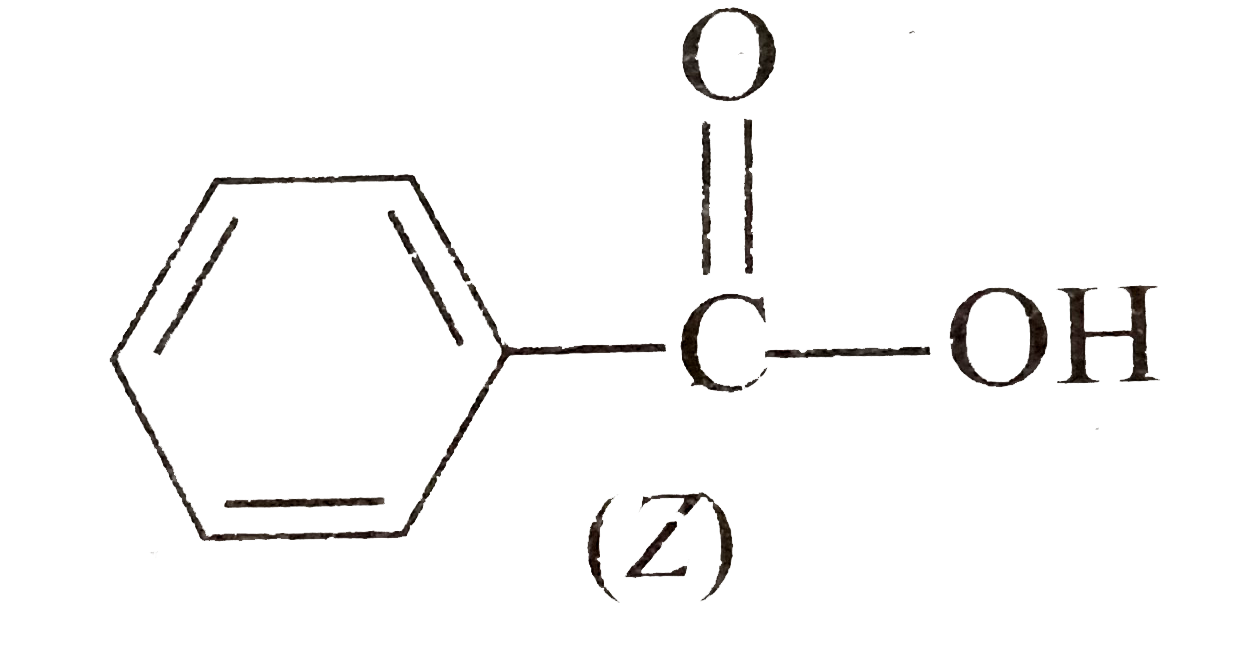Decreasing order of acid strength is : Ph−(A)OH, Ph−C(B)H2−OH, Ph−CO2H, Ph−C(D)H2−⊕NH3
B>A>C>D
C>A>B>D
C>A>D>B
C>B>A>D
The correct Answer is:C
To determine the decreasing order of acid strength for the compounds given, we need to analyze the stability of the conjugate bases formed when each compound donates a proton (H+). The more stable the conjugate base, the stronger the acid.
1. Identify the Compounds:
- (A) Ph-OH (Phenol)
- (B) Ph-CH2-OH (Benzyl alcohol)
- (C) Ph-CO2H (Benzoic acid)
- (D) Ph-CH2-NH3+ (Benzylammonium ion)
2. Determine the Conjugate Bases:
- For (A) Ph-OH, the conjugate base is Ph-O⁻ (phenoxide ion).
- For (B) Ph-CH2-OH, the conjugate base is Ph-CH2-O⁻ (benzyl oxide ion).
- For (C) Ph-CO2H, the conjugate base is Ph-CO2⁻ (benzoate ion).
- For (D) Ph-CH2-NH3+, the conjugate base is Ph-CH2-NH2 (benzylamine).
3. Analyze the Stability of Conjugate Bases:
- (A) Ph-O⁻: The negative charge on oxygen can be delocalized due to resonance with the aromatic ring, making it relatively stable.
- (B) Ph-CH2-O⁻: The negative charge is localized on the oxygen and does not have resonance stabilization from the aromatic ring, making it less stable than Ph-O⁻.
- (C) Ph-CO2⁻: The negative charge is delocalized over two oxygen atoms in the carboxylate ion, making it very stable and thus, benzoic acid is a strong acid.
- (D) Ph-CH2-NH2: This is a neutral amine and does not have a negative charge, making it the least acidic.
4. Rank the Acids:
- Strongest Acid: (C) Ph-CO2H (Benzoic acid) - due to the resonance stabilization of the conjugate base.
- Next Strongest: (A) Ph-OH (Phenol) - resonance stabilization of phenoxide ion.
- Next: (B) Ph-CH2-OH (Benzyl alcohol) - no resonance stabilization.
- Weakest Acid: (D) Ph-CH2-NH3+ (Benzylammonium ion) - neutral and not acidic.
5. Final Order:
- The decreasing order of acid strength is: Ph-CO2H > Ph-OH > Ph-CH2-OH > Ph-CH2-NH3+.
Final Answer:
The order of decreasing acid strength is: C > A > B > D.
- (A) Ph-OH (Phenol)
- (B) Ph-CH2-OH (Benzyl alcohol)
- (C) Ph-CO2H (Benzoic acid)
- (D) Ph-CH2-NH3+ (Benzylammonium ion)
- For (A) Ph-OH, the conjugate base is Ph-O⁻ (phenoxide ion).
- For (B) Ph-CH2-OH, the conjugate base is Ph-CH2-O⁻ (benzyl oxide ion).
- For (C) Ph-CO2H, the conjugate base is Ph-CO2⁻ (benzoate ion).
- For (D) Ph-CH2-NH3+, the conjugate base is Ph-CH2-NH2 (benzylamine).
- (A) Ph-O⁻: The negative charge on oxygen can be delocalized due to resonance with the aromatic ring, making it relatively stable.
- (B) Ph-CH2-O⁻: The negative charge is localized on the oxygen and does not have resonance stabilization from the aromatic ring, making it less stable than Ph-O⁻.
- (C) Ph-CO2⁻: The negative charge is delocalized over two oxygen atoms in the carboxylate ion, making it very stable and thus, benzoic acid is a strong acid.
- (D) Ph-CH2-NH2: This is a neutral amine and does not have a negative charge, making it the least acidic.
- Strongest Acid: (C) Ph-CO2H (Benzoic acid) - due to the resonance stabilization of the conjugate base.
- Next Strongest: (A) Ph-OH (Phenol) - resonance stabilization of phenoxide ion.
- Next: (B) Ph-CH2-OH (Benzyl alcohol) - no resonance stabilization.
- Weakest Acid: (D) Ph-CH2-NH3+ (Benzylammonium ion) - neutral and not acidic.
- The decreasing order of acid strength is: Ph-CO2H > Ph-OH > Ph-CH2-OH > Ph-CH2-NH3+.
The order of decreasing acid strength is: C > A > B > D.
Topper's Solved these Questions
- BOOK - MS CHOUHANCHAPTER - GENERAL ORGANIC CHEMISTRYEXERCISE - LEVEL- 11videos
GENERAL ORGANIC CHEMISTRY
- BOOK - MS CHOUHANCHAPTER - FAMILIES OF CARBON COMPOUNDS: FUNCTIONAL GROUPS AND INTERMOLECULAR FORCES EXERCISE - ADDITIONAL OBJECTIVE QUESTIONS ( Matrix Match Type )4videos
FAMILIES OF CARBON COMPOUNDS: FUNCTIONAL GROUPS AND INTERMOLECULAR FORCES
- BOOK - MS CHOUHANCHAPTER - GRIGNARD REAGENTSEXERCISE - Level 1 (Q.61 To Q.66)1videos
GRIGNARD REAGENTS
Similar Questions
Knowledge Check
- Question 1 - Select One
Correct the decreasing order of basic strength
ϴOH(a) ϴNH2(b) ϴHC≡C(c) ϴCH3−CH2(d)Ab>a>c>dBa>b>c>dCd>b>c>aDc>b>a>d - Question 2 - Select One
Give the correct order of decreasing acidity :
C2H5S(I)H
C2H5OH(2)
C2H5NH2(3)
CH3CH2CH3(4)A2>1>3>4B3>2>1>4C1>2>3>4D3>4>2>1 - Question 3 - Select One
Arrange the following acid in decreasing order of their acidic strength :
(I) CH3−OH (II) CH3CH2−OH
(III) CH3−CH∣CH3−OH (IV) CH3−CH3∣C∣CH3−OHAII>III>IV>IBI>II>III>IVCI>III>II>IVDII>IV>III>I
Write the correct order of acidic strength of following compounds:
(a)CH3−CH2−O−H (b)CH3−C∣CH3H−O−H
(c)CH3−CH3∣C∣CH3−O−HView SolutionThe correct order of reactivity of Ph Mg Br with
Ph−O∣∣CC−Ph(I) CH3−O∣∣C−H(II) CH3−O∣∣C−CH3(III) isView SolutionArrage the following acids in decreasing order of acidity :
H−O∣∣C(X)−OH CH3−O∣∣C(Y)−OH View Solution
View SolutionThe correct order of reactivity of PhMgBr with
Ph−O∣∣C−Ph(I),CH3−O∣∣C−H(II) and CH3−O∣∣C−CH3(III)View SolutionThe IUPAC name for
CH3−CH∣OH−CH2−CH3∣C∣OH−CH3 is:View Solution

